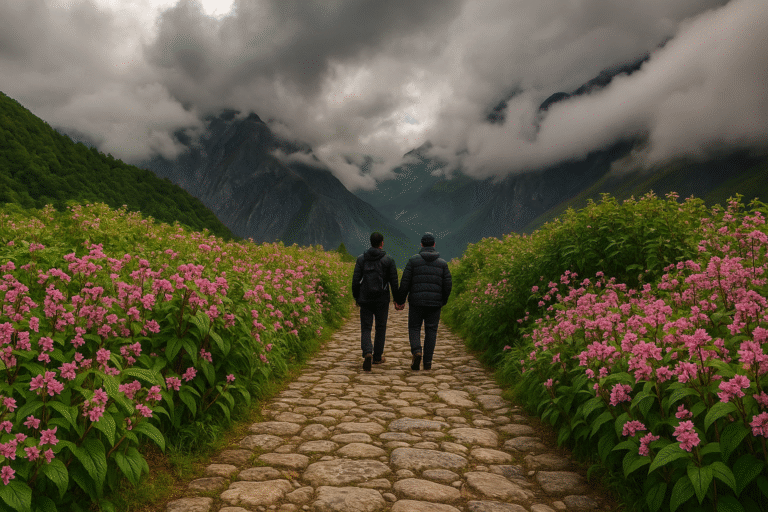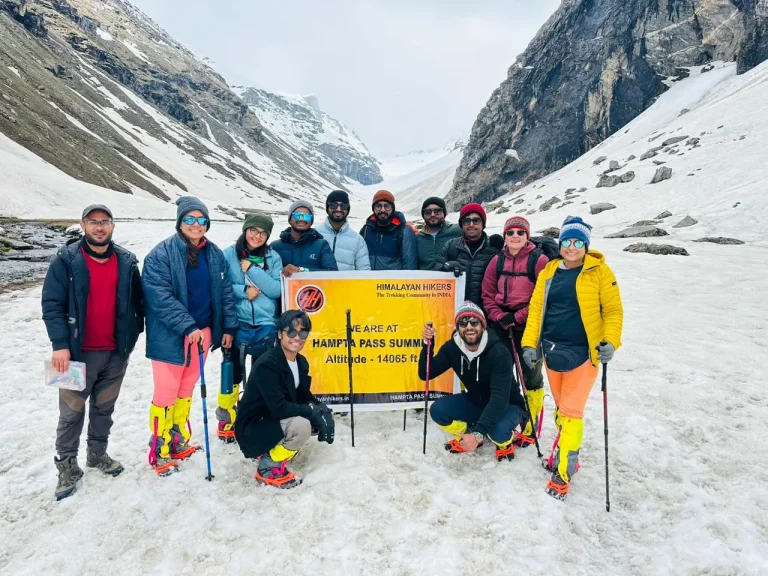-
Valley of Flowers: Where the Gods Whisper in Petals
They call it a valley, but it's not just that.
It’s a prayer written in flowers.
A place where myths hide in meadows, and every step feels like you’re walking through a forgotten story.
1. The Bloom That Waits for You — and Only You
The flowers don’t bloom for everyone.
Locals believe the valley chooses its own travelers. If you’re meant to see the rare blue poppy, it’ll bloom for you — and only for you.
They say:
"Jo phool tujhe dikhega, woh tere liye khila hoga."
(The flower you see bloomed just for you.)
This belief is why many old pilgrims walk barefoot, whispering to the wind:
“Let the valley know I’ve come in peace.”
2. The Valley of Flowers Was Once a War Ground?
Yes — but not a human war.
An old folklore says that long ago, mountain spirits and forest guardians fought to protect the valley from those who wanted to “tame” it.
Even today, some corners of the valley — especially near the Pushpawati River — feel strangely still, as if the air itself remembers the battles.
Local women don’t pluck flowers there.
They believe that even silence is sacred in those zones.
3. The Phantom Monks of Hemkund
Before Hemkund Sahib became a pilgrim site, locals whispered about the "Gumnaam Sadhu" — faceless monks who meditated in the wild, never eating, never speaking.
Many believe these sages still appear as clouds over the valley, especially during sunrise.
If you see a thin fog dancing alone, don’t disturb it.
“Let the monk pass,” an old guide says.
“He’s not walking in this world anymore.”
4. The Flower That Heals Regret
Among the hundreds of blooms, there’s one called "Dard-Mita" — literally, “pain remover.”
It doesn’t appear in books.
Only the old villagers of Ghangaria know where to find it.
They say if you sit beside it quietly, thinking about something you regret — a word unsaid, a dream left behind — the flower will sway even if there’s no wind.
Not to answer you.
Just to remind you that even unspoken prayers are heard here.
5. Why It Always Rains When You Enter the Valley
Almost every traveler notices it.
Just as you step past the gate — drizzle.
A sudden, quiet, misty rain.
Locals call it the "welcome wash."
A final cleansing before you walk into nature’s holy place.
Because no one is allowed to enter the Valley with a heavy heart.
6. The Meadow of Lost Names
Far inside the valley, past the main trail, lies a hidden patch called "Naam-Gum Maidan" — the Meadow of Forgotten Names.
Legend says this is where people who died without farewells are remembered by the mountain.
Sit there long enough, and you might hear a name whispered by the wind — not yours, not anyone you know.
But someone who needed to be remembered one last time.
7. You Don’t Just Visit the Valley — You Return to Yourself
When you leave the Valley of Flowers, you don’t return the same.
You come back quieter.
Not sad, not broken — just emptied of noise.
And you start noticing flowers growing in your life where there was once only worry.
Because this valley doesn’t just bloom in Uttarakhand —
it starts blooming in your heart.
Want to Experience It with the Ones Who Know Its Soul?
https://www.himalayanhikers.in/valley-of-flowers-trek/
Come as a trekker. Leave as someone who finally listened.
Valley of Flowers: Where the Gods Whisper in Petals They call it a valley, but it's not just that. It’s a prayer written in flowers. A place where myths hide in meadows, and every step feels like you’re walking through a forgotten story. 1. The Bloom That Waits for You — and Only You The flowers don’t bloom for everyone. Locals believe the valley chooses its own travelers. If you’re meant to see the rare blue poppy, it’ll bloom for you — and only for you. They say: "Jo phool tujhe dikhega, woh tere liye khila hoga." (The flower you see bloomed just for you.) This belief is why many old pilgrims walk barefoot, whispering to the wind: “Let the valley know I’ve come in peace.” 2. The Valley of Flowers Was Once a War Ground? Yes — but not a human war. An old folklore says that long ago, mountain spirits and forest guardians fought to protect the valley from those who wanted to “tame” it. Even today, some corners of the valley — especially near the Pushpawati River — feel strangely still, as if the air itself remembers the battles. Local women don’t pluck flowers there. They believe that even silence is sacred in those zones. 3. The Phantom Monks of Hemkund Before Hemkund Sahib became a pilgrim site, locals whispered about the "Gumnaam Sadhu" — faceless monks who meditated in the wild, never eating, never speaking. Many believe these sages still appear as clouds over the valley, especially during sunrise. If you see a thin fog dancing alone, don’t disturb it. “Let the monk pass,” an old guide says. “He’s not walking in this world anymore.” 4. The Flower That Heals Regret Among the hundreds of blooms, there’s one called "Dard-Mita" — literally, “pain remover.” It doesn’t appear in books. Only the old villagers of Ghangaria know where to find it. They say if you sit beside it quietly, thinking about something you regret — a word unsaid, a dream left behind — the flower will sway even if there’s no wind. Not to answer you. Just to remind you that even unspoken prayers are heard here. 5. Why It Always Rains When You Enter the Valley Almost every traveler notices it. Just as you step past the gate — drizzle. A sudden, quiet, misty rain. Locals call it the "welcome wash." A final cleansing before you walk into nature’s holy place. Because no one is allowed to enter the Valley with a heavy heart. 6. The Meadow of Lost Names Far inside the valley, past the main trail, lies a hidden patch called "Naam-Gum Maidan" — the Meadow of Forgotten Names. Legend says this is where people who died without farewells are remembered by the mountain. Sit there long enough, and you might hear a name whispered by the wind — not yours, not anyone you know. But someone who needed to be remembered one last time. 7. You Don’t Just Visit the Valley — You Return to Yourself When you leave the Valley of Flowers, you don’t return the same. You come back quieter. Not sad, not broken — just emptied of noise. And you start noticing flowers growing in your life where there was once only worry. Because this valley doesn’t just bloom in Uttarakhand — it starts blooming in your heart. 🌐 Want to Experience It with the Ones Who Know Its Soul? 👉 https://www.himalayanhikers.in/valley-of-flowers-trek/ Come as a trekker. Leave as someone who finally listened.0 Commentarii ·0 Distribuiri ·263 Views ·0 previzualizare -
Hampta Pass: The Trail Where Gods Changed Clothes
They say if you sit quietly at the edge of Balu Ka Ghera just before dawn, you’ll hear the Himalayas breathe.
That’s not a metaphor.
That’s the first lesson the mountain gives you on the Hampta Pass Trek — you’re not here to conquer the trail.
You’re here to be stripped of ego, just like the shepherds and sadhus once were.
1. The Shepherds’ Hidden Route to Nowhere
Before GPS and glossy maps, Gaddi shepherds from the Kullu Valley used this pass for a strange reason: to disappear.
During summers, when monsoon floods ruined lowland pastures, they led their flocks across Hampta — not just to reach Lahaul, but to cleanse their karma.
Locals still believe that one night under the stars at Shea Goru can undo years of emotional weight. “That’s why no one cries here,” an old shepherd told me, “because the mountain has already wept for you.”
2. Hampta – Where Mountains Change Their Skin
Nowhere else in India will you see this sudden switch of landscapes:
One minute you’re in lush green Kullu,
The next, you step into the cold desert of Lahaul — barren, silent, and wild.
An old folklore from Jobra village says:
“Hampta is where the Himalayas change their robes. Green for the living, grey for the spirits.”
They believe that as you cross the pass, your spirit walks a second trail — invisible but watched. If both reach the other side together, you come back lighter, calmer, clearer.
3. Balu Ka Ghera — The Ashes of a Divine Fire?
Most trekkers sleep at Balu Ka Ghera, thinking it’s just a sandy campsite.
But do you know what “Balu” means here?
Not sand — but ashes.
Ancient nomads believe that Lord Shiva once meditated here, and the fire from his tapasya left behind black sand. Even today, some stones here smell faintly of burnt wood. Locals advise not to laugh too loudly at night here — “The ash still listens.”
4. The Wind That Teaches You Humility
As you climb toward Hampta Pass (4270m), there’s a point where the wind hits you from both sides — Kullu behind, Lahaul ahead.
It’s called “Do-Disha Hawaa” — “The Two-Direction Wind.”
Shepherds say it’s the only place where:
“You hear the mountain speak to itself.”
Many trekkers feel an eerie silence here, even in storms. Some say it’s the mountain testing your resolve. Others call it the wind’s final warning before you cross into the cold emptiness of Spiti’s edge.
5. The Crying Stream of Shea Goru
Ever heard a glacier stream weep?
At Shea Goru, early risers often hear what sounds like a woman sobbing. The stream here flows fast, yet softly.
Villagers from Chhatru believe that the stream is a daughter of the mountain, cursed to wait for travelers who never return.
Some say if you sit quietly with wet feet in the stream and speak the name of a lost loved one, you’ll dream of them that night.
6. The Silent Shrine of Chhatru
Near the final campsite, hidden behind rocks, is a tiny shrine of Lord Bholenath made only of stone and red thread.
Locals say it was built by a lost shepherd who survived a storm by taking shelter near a boulder — and saw a shadow feeding his sheep in the snowstorm.
The next morning, all his sheep were alive, untouched.
He returned the next year to build a shrine with his bare hands, and left behind his last words:
“Jisne jaan bachayi, woh chhupa nahi, woh hamare paas hi tha.”
(The one who saved me didn’t hide — he was always close.)
7. What This Trek Truly Does to You
Hampta Pass is not just a trek.
It’s a transition. A cleanse. A crossing.
It pulls you from lushness to barrenness, not just outside, but within.
Here, you lose your comfort.
Your breath gets heavier.
And strangely, your heart gets lighter.
You come back not with “content,” but with clarity.
Book the Trek with the People Who Know the Valley’s Soul
https://www.himalayanhikers.in/hampta-pass-trek/
Not just a trek. A passage. A purification.
Hampta Pass: The Trail Where Gods Changed Clothes They say if you sit quietly at the edge of Balu Ka Ghera just before dawn, you’ll hear the Himalayas breathe. That’s not a metaphor. That’s the first lesson the mountain gives you on the Hampta Pass Trek — you’re not here to conquer the trail. You’re here to be stripped of ego, just like the shepherds and sadhus once were. 1. The Shepherds’ Hidden Route to Nowhere Before GPS and glossy maps, Gaddi shepherds from the Kullu Valley used this pass for a strange reason: to disappear. During summers, when monsoon floods ruined lowland pastures, they led their flocks across Hampta — not just to reach Lahaul, but to cleanse their karma. Locals still believe that one night under the stars at Shea Goru can undo years of emotional weight. “That’s why no one cries here,” an old shepherd told me, “because the mountain has already wept for you.” 2. Hampta – Where Mountains Change Their Skin Nowhere else in India will you see this sudden switch of landscapes: One minute you’re in lush green Kullu, The next, you step into the cold desert of Lahaul — barren, silent, and wild. An old folklore from Jobra village says: “Hampta is where the Himalayas change their robes. Green for the living, grey for the spirits.” They believe that as you cross the pass, your spirit walks a second trail — invisible but watched. If both reach the other side together, you come back lighter, calmer, clearer. 3. Balu Ka Ghera — The Ashes of a Divine Fire? Most trekkers sleep at Balu Ka Ghera, thinking it’s just a sandy campsite. But do you know what “Balu” means here? Not sand — but ashes. Ancient nomads believe that Lord Shiva once meditated here, and the fire from his tapasya left behind black sand. Even today, some stones here smell faintly of burnt wood. Locals advise not to laugh too loudly at night here — “The ash still listens.” 4. The Wind That Teaches You Humility As you climb toward Hampta Pass (4270m), there’s a point where the wind hits you from both sides — Kullu behind, Lahaul ahead. It’s called “Do-Disha Hawaa” — “The Two-Direction Wind.” Shepherds say it’s the only place where: “You hear the mountain speak to itself.” Many trekkers feel an eerie silence here, even in storms. Some say it’s the mountain testing your resolve. Others call it the wind’s final warning before you cross into the cold emptiness of Spiti’s edge. 5. The Crying Stream of Shea Goru Ever heard a glacier stream weep? At Shea Goru, early risers often hear what sounds like a woman sobbing. The stream here flows fast, yet softly. Villagers from Chhatru believe that the stream is a daughter of the mountain, cursed to wait for travelers who never return. Some say if you sit quietly with wet feet in the stream and speak the name of a lost loved one, you’ll dream of them that night. 6. The Silent Shrine of Chhatru Near the final campsite, hidden behind rocks, is a tiny shrine of Lord Bholenath made only of stone and red thread. Locals say it was built by a lost shepherd who survived a storm by taking shelter near a boulder — and saw a shadow feeding his sheep in the snowstorm. The next morning, all his sheep were alive, untouched. He returned the next year to build a shrine with his bare hands, and left behind his last words: “Jisne jaan bachayi, woh chhupa nahi, woh hamare paas hi tha.” (The one who saved me didn’t hide — he was always close.) 7. What This Trek Truly Does to You Hampta Pass is not just a trek. It’s a transition. A cleanse. A crossing. It pulls you from lushness to barrenness, not just outside, but within. Here, you lose your comfort. Your breath gets heavier. And strangely, your heart gets lighter. You come back not with “content,” but with clarity. Book the Trek with the People Who Know the Valley’s Soul 👉 https://www.himalayanhikers.in/hampta-pass-trek/ Not just a trek. A passage. A purification.0 Commentarii ·0 Distribuiri ·280 Views ·0 previzualizare
Mai multe povesti







